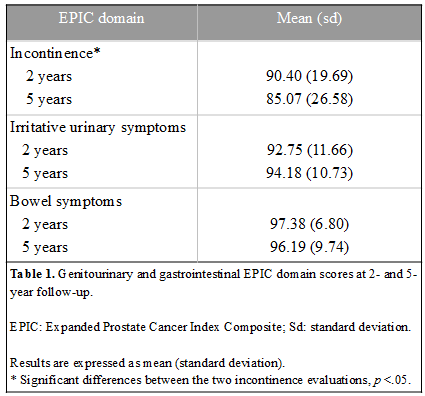Dose-escalated hypofractionated radiotherapy to 66Gy in localized prostate cancer: long-term results
Antonio Lazo Prados,
Spain
PO-1413
Abstract
Dose-escalated hypofractionated radiotherapy to 66Gy in localized prostate cancer: long-term results
Authors: Antonio Lazo Prados1, Alejandro De la Torre-Luque2, Gregorio Arregui Castillo3, Escarlata Lopez Ramirez4, Mª Isabel Nuñez Torres5
1H.U. San Cecilio, Radiation Oncology, Granada, Spain; 2Complutense University, Legal Medicine, Psychiatry and Pathology, Madrid, Spain; 3GenesisCare, Department of Physics , Granada, Spain; 4GenesisCare , Chief Medical Office, Madrid, Spain; 5Granada University, Department of Radiology and Physical Medicine, Granada, Spain
Show Affiliations
Hide Affiliations
Purpose or Objective
Hypofractionated
radiation therapy (HFRT) is an effective treatment for localized
prostate cancer (Pca) that
has demonstrated to be equivalent
to conventional schedules in terms of biochemical control and
toxicity. On the other hand, conventional fractionated dose-escalation has shown to improve biochemical control and distant metastases,
but it does not improve overall survival. This study aimed to provide some clinical outcomes
regarding effectiveness, toxicity and quality of life in PCa patients
treated with dose-escalated HFRT to a dose of 66 Gy delivered via
Volume Modulated Arc Therapy (VMAT).
Material and Methods
One
hundred and twenty-two patients (122)
patients
with localized PCa were retrospectively evaluated. They received 66
Gy in 22 fractions (3 Gy/fraction, 5 fractions/week) using
VMAT, between 2011-2016. Treatment effectiveness was measured by
failure-free survival and
overall survival rates.
Toxicity was assessed according to the criteria of RTOG/EORTC.
Quality
of life (QoL)
was longitudinally evaluated,
at a
median of 2 and 5 years after RT, according to the EPIC-26
questionnaire score.
Results
Median
follow-up was 75 months. The
overall survival and the biochemical failure-free survival rate
was 93.8% and 94.2%, respectively. No
patients died from PCa (PCa specific survival was 100%) The incidence of acute grade 2 or higher gastrointestinal
(GI) and genitourinary (GU) toxicity was 9.84% and 28.69%,
respectively. The incidence rate of late grade 2 or higher GI and GU toxicity was 1.64% and 4.10%, respectively. EPIC scores generally showed excellent results with a
slight decrease in QoL related to the incontinence domain (Table 1).

Conclusion
HFRT
to 66 Gy with VMAT is associated with excellent biochemical control
and
overall survival results,
low toxicity and good reported QoL
outcomes.